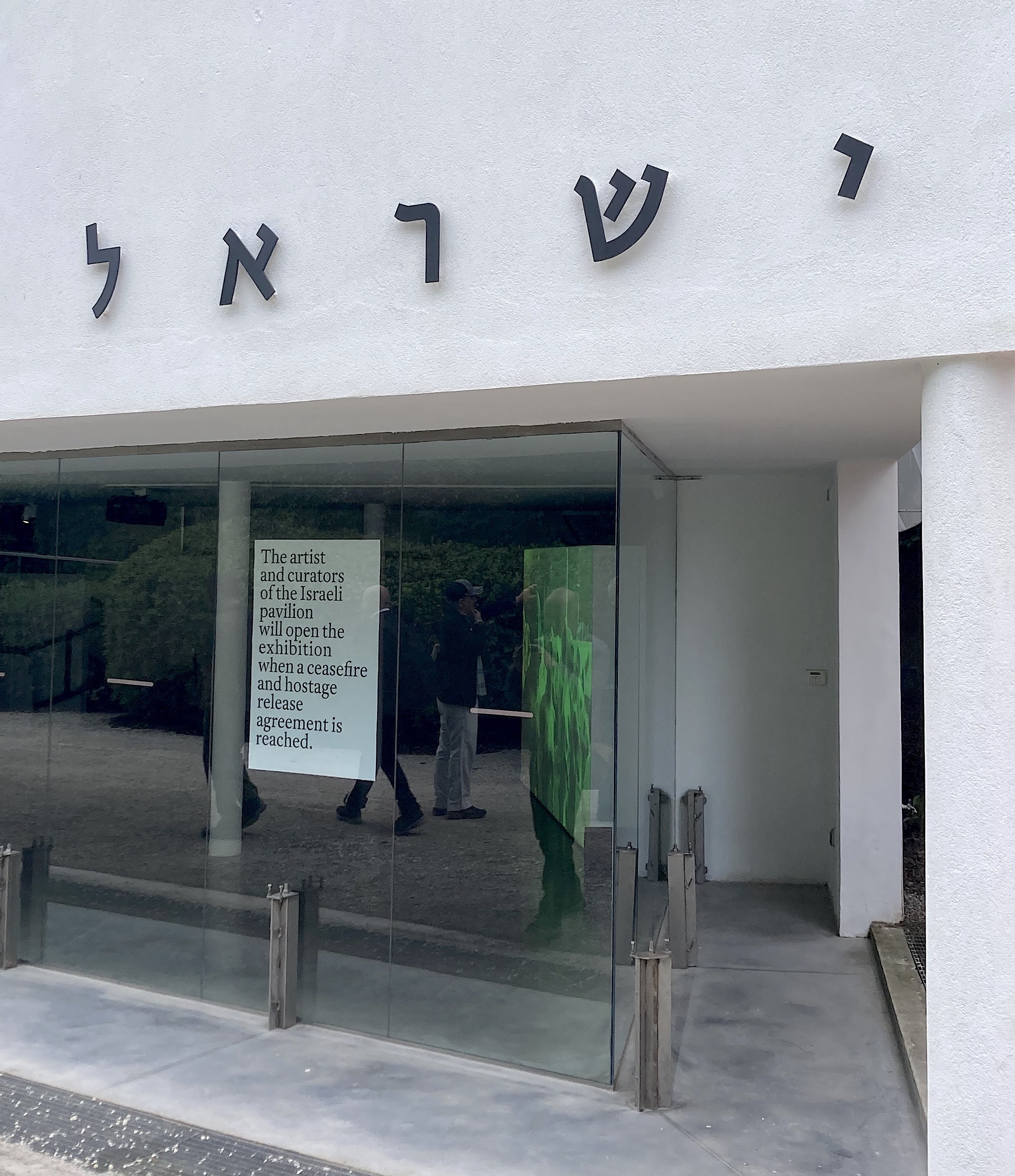Israel Shutters Venice Pavilion, Activists Decry Opportunism
By Anna Lentchner

Exterior of the Israel Pavilion at the 60th Venice Biennale. Photo by HG Masters for ArtAsiaPacific.
In protest of the continued war in Gaza, the Israel Pavilion at the 60th Venice Biennale will only open “when a ceasefire and hostage release agreement is reached,” according to a notice affixed to its window on April 16. The decision to shutter the pavilion was made by Israeli national artist Ruth Patir and the exhibition’s co-curators, Mira Lapidot and Tamar Margalit.
While the Venice Biennale opens to the public on April 20, media previews commenced on Tuesday. Attendees found the doors to the pavilion locked, although one of Patir’s video works—a two-minute animation of grieving and enraged fertility statues that Patir told The New York Times “felt accurate to the experience of living in this moment”—is visible through the glass windows. Titled “(M)otherland,” the exhibition intended to explore issues of motherhood and the widespread pressure for women to live up to such ideals.
Patir stated on Instagram: “I feel that the time for art is lost and I need to believe it will return. [Margalit, Lapidot] and I have become the news, not the art. And so if I am given such a remarkable stage, I want to make it count . . . I am an artist and educator, I firmly object to cultural boycott, but . . . I prefer to raise my voice with those I stand with in their scream, ceasefire now, bring the people back from captivity. We can’t take it anymore.”
The news comes after weeks of protests that sought to prohibit Israel from participating in the biennale. Among the most notable was an open letter by the activist group Art Not Genocide Alliance (AGNA) that circulated in February, garnering nearly 24,000 signatories—including from high-profile artists such as Adam Broomberg, Nan Goldin, Mike Parr, and Michael Rakowitz. The petition stated that “Platforming art representing a state engaged in ongoing atrocities against Palestinians in Gaza is unacceptable.”
The Israel Pavilion did not directly respond, but the Venice Biennale affirmed that “all countries recognized by the Italian Republic may autonomously request to participate.” Participation, however, is voluntary. When Russia invaded Ukraine in 2022, artists and curators of its national pavilion respectfully withdrew from the biennale. This year Russia has once again abstained, and its large-scale venue is being taken up by Bolivia. Palestine, meanwhile, continues to lack its own pavilion, as Italy does not recognize it as a sovereign state. Instead, the Palestine Museum US is organizing a collateral exhibition, “Foreigners in Their Homeland.”
As for why the Israel Pavilion did not withdraw, Patir said she hoped the conflict would cease by the time the biennale took place, and that neither she nor the curators imagined they “would be in Venice in April with the hostages still in captivity, with the war still raging.” The Israeli government, which is funding nearly half of the presentation, was reportedly unaware of the protest.
AGNA responded on April 16 via Instagram, reiterating its call to shut the pavilion down entirely and deeming the closing “a direct consequence of widespread pressure and our collective campaign.” If further stated: “AGNA does not applaud empty and opportunistic gestures timed for maximum press coverage, and leaving video works on view to the public, while Palestinians are killed by Israel every hour and millions face imminent famine.”
According to Al Jazeera, it is estimated that 129 of the 240 people taken hostage on October 7, when Hamas militants invaded southern Israel, remain in Gaza; 34 are presumed dead. Approximately 34,000 Palestinians have been killed since the war began and the population continues to lack essential humanitarian aid. Meanwhile, escalating tensions between Iran and Israel threaten to instigate a wider regional conflict.
Anna Lentchner is assistant editor at ArtAsiaPacific.







